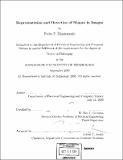Representation and detection of shapes in images
Author(s)
Felzenszwalb, Pedro F., 1976-
DownloadFull printable version (6.702Mb)
Other Contributors
Massachusetts Institute of Technology. Department of Electrical Engineering and Computer Science.
Advisor
W. Eric L. Grimson.
Terms of use
Metadata
Show full item recordAbstract
We present a set of techniques that can be used to represent and detect shapes in images. Our methods revolve around a particular shape representation based on the description of objects using triangulated polygons. This representation is similar to the medial axis transform and has important properties from a computational perspective. The first problem we consider is the detection of non-rigid objects in images using deformable models. We present an efficient algorithm to solve this problem in a wide range of situations, and show examples in both natural and medical images. We also consider the problem of learning an accurate non-rigid shape model for a class of objects from examples. We show how to learn good models while constraining them to the form required by the detection algorithm. Finally, we consider the problem of low-level image segmentation and grouping. We describe a stochastic grammar that generates arbitrary triangulated polygons while capturing Gestalt principles of shape regularity. This grammar is used as a prior model over random shapes in a low level algorithm that detects objects in images.
Description
Thesis (Ph. D.)--Massachusetts Institute of Technology, Dept. of Electrical Engineering and Computer Science, 2003. Includes bibliographical references (p. 79-83).
Date issued
2003Department
Massachusetts Institute of Technology. Department of Electrical Engineering and Computer SciencePublisher
Massachusetts Institute of Technology
Keywords
Electrical Engineering and Computer Science.